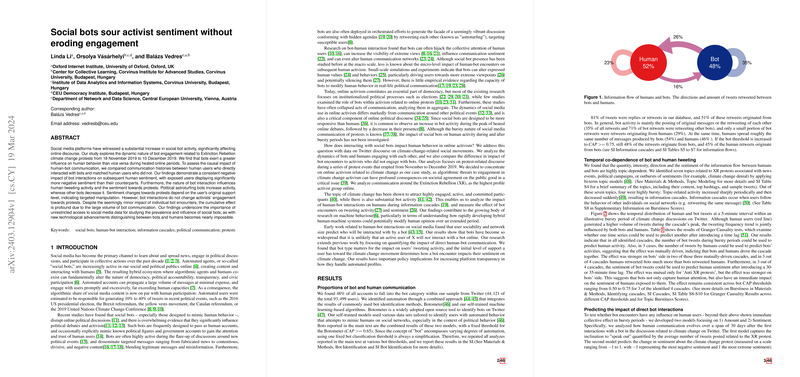Social Bots Sour Activist Sentiment Without Eroding Engagement
The paper "Social bots sour activist sentiment without eroding engagement" by Linda Li, Orsolya Varhelyi, and Balazs Vedres presents a comprehensive paper of social bot activity on Twitter, focusing on the micro-level interactions between bots and human users during the Extinction Rebellion climate change protests. This research is rooted in the broader context of political communication and the significant impact of automated online agents—referred to as social bots—on the perception and behavior of human participants in online activism.
Methodology and Findings
The paper utilizes a dataset of Twitter interactions related to Extinction Rebellion protests from November 18, 2019, to December 10, 2019. Through the combined implementation of the Botometer tool and self-trained machine learning models, the authors identify 48% of the participating accounts as bots, based on a robust identification protocol. The findings indicate that bots substantially contribute to the volume of protest-related tweets and have a greater impact on human activity during bursty periods of online discourse compared to the influence of humans on bots.
Key findings include:
- Proportions of Communication:
- 48% of the users in the sample were identified as bots.
- Bots accounted for 51% of all retweets, with bots predominantly retweeting other bots (71%).
- Human users retweeted content from both bots and other humans in nearly equal proportions.
- Temporal Co-dependence:
- Using Granger causality tests, the paper shows that the volume and sentiment of bot tweets can predict human activity and sentiment in subsequent periods, particularly during topics with bursty activity.
- Sentiment and Activism:
- A significant negative impact on human sentiment follows bot interactions, with exposed users showing more negative attitudes compared to non-exposed users. Despite this negativity, there was no significant reduction in the overall engagement of activists towards the protests.
- Interaction with politically motivated astroturfing bots increases human tweeting activity, whereas other bots tend to decrease it.
Practical and Theoretical Implications
The implications of these findings are multifaceted:
- Political Communication:
- The nature of bot interactions underscores the potential for automated accounts to shape public discourse, especially during politically charged events. Astroturfing bots, aimed at mimicking grassroots movements, exacerbate engagement by driving conversations through provocative content.
- The sentiment manipulation performed by these bots can make online activism appear more polarized than it may be, affecting public perception and possibly influencing broader political sentiment.
- Algorithmic Influence on Activism:
- As bots target individuals with potentially malleable opinions, the paper highlights an evident risk of skewing public opinion. The cumulative effect of these interactions is substantial, despite the seemingly small impact of individual encounters.
- Policy Recommendations:
- The results suggest that there should be increased transparency regarding the management and operation of automated accounts on social media platforms. Regulatory frameworks such as those proposed by the European Union's Digital Services Act are crucial to mandate such transparency.
- Social media platforms must be guided to provide researchers with access to comprehensive data sets of public interactions to accurately paper and understand the influence and prevalence of bots.
Future Developments in AI
Looking forward, the rapid advancements in AI, particularly in LLMs, pose new challenges for bot detection and human-bot interaction dynamics. As bots become increasingly sophisticated and human-like, the ability to distinguish between bot and human activity will diminish significantly, requiring continuous evolution in bot detection methodologies.
Conclusion
This paper underscores the compelling need for ongoing research and regulatory oversight to address the consequences of bot activity on social media, particularly within the sphere of political communications and online activism. By thoroughly investigating the Extinction Rebellion protests' data, the authors provide an essential framework for understanding the intricate dynamics of human-bot interactions and their implications for democratic engagement and public discourse.
